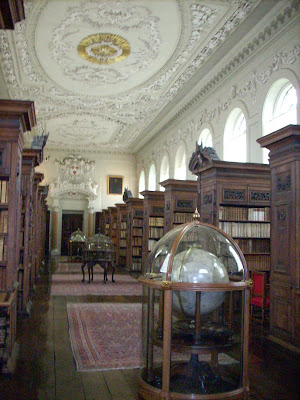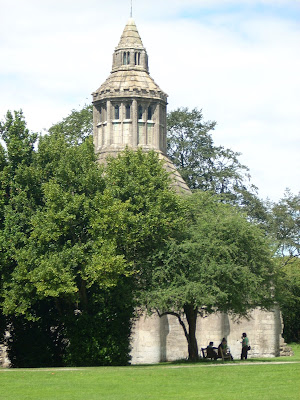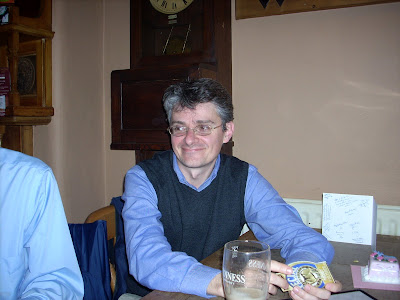
Sunday, 22 July 2007
University Parks

At the Sign of the Red Pale

Tolkien's Oxford

 Mark walked many miles to visit the many sites in Oxford associated with J.R.R. Tolkien and C.S. Lewis. Here, Mark and Pablo are at the famed Eagle and Child Pub where Tolkien, Lewis and other members of the writing group, the Inklings, met to share their writing. The photo of Mark standing is in the room where the Inklings typically met.
Mark walked many miles to visit the many sites in Oxford associated with J.R.R. Tolkien and C.S. Lewis. Here, Mark and Pablo are at the famed Eagle and Child Pub where Tolkien, Lewis and other members of the writing group, the Inklings, met to share their writing. The photo of Mark standing is in the room where the Inklings typically met.Young Scholars

Thursday, 19 July 2007
Thursday, 12 July 2007
Land of Arthur--the Cornish Sea

Land of Arthur--Glastonbury Abbey
land of Arthur--Glastonbury Abbey


Land of Arthur--Glastonbury Tor

 ort have been found on the Tor and much work has been done by local Arthurian historian, the venerable Geoffrey Ashe, to prove the historical basis of a 5th century Briton war leader. A chapel once stood at the top of the hill but was destroyed by earthquake and rebuilt only to crumble before that other earthquake of English culture: Henry VIII, whose dissolution of the monasteries brought about the ruin of this chapel as well. It is said that the abbot of Glastonbury Abbey was hanged up on this hill along with two other monks for his refusal to turn over the monastery to Henry.
ort have been found on the Tor and much work has been done by local Arthurian historian, the venerable Geoffrey Ashe, to prove the historical basis of a 5th century Briton war leader. A chapel once stood at the top of the hill but was destroyed by earthquake and rebuilt only to crumble before that other earthquake of English culture: Henry VIII, whose dissolution of the monasteries brought about the ruin of this chapel as well. It is said that the abbot of Glastonbury Abbey was hanged up on this hill along with two other monks for his refusal to turn over the monastery to Henry.Wednesday, 11 July 2007
We interrupt this Arthurian quest for a bit of comic relief
Land of Arthur--The Round Table
 Winchester also holds great interest for Malory readers as a 14th century version of Arthur's Round Table resides in the Great Hall of Winchester Castle, a structure that dates back to the time of William the Conqueror (1066-1087). The famed green and beige table is a massive piece of wood joinery that now hangs on the wall of the Great Hall. The historical Arthur is said to have ruled around the 5th or 6th century BC but this table is dated to the 14th century and painted in its current color scheme by Henry the VIII in the early 16th century. In Malory' s great tale, the table is a wedding gift to Arthur from Guinevere's father, Leodegrance.
Winchester also holds great interest for Malory readers as a 14th century version of Arthur's Round Table resides in the Great Hall of Winchester Castle, a structure that dates back to the time of William the Conqueror (1066-1087). The famed green and beige table is a massive piece of wood joinery that now hangs on the wall of the Great Hall. The historical Arthur is said to have ruled around the 5th or 6th century BC but this table is dated to the 14th century and painted in its current color scheme by Henry the VIII in the early 16th century. In Malory' s great tale, the table is a wedding gift to Arthur from Guinevere's father, Leodegrance.Land of Arthur--Winchester College

Land of Arthur--WInchester Cathedral

Land of Arthur--Winchester Cathedral

Tuesday, 10 July 2007
St. John's Library


Queen's College Library


Wednesday, 4 July 2007
Evensong at Christ Church

- Here is the last stanza, a favorite of my family's:
- To hear the tune (missing the soaring voices of the boys' choir) click here.
Tuesday, 3 July 2007
Duke Humphrey's Library at the Bodleian Library

Monday, 2 July 2007
The Sculler's Travels

It seems appropriate here to include a text I have been interested in for a while. A perfect confluence of interests: early printed books and rowing. The complete title: Taylors vvater-vvorke: or the scullers trauels, from Tiber to Thames: with his boat laden with a hotch-potch, or gallimawfrey of sonnets, satyres, and epigrams. With an inkhorne disputation betwixt a lawyer and a poet: and a quarterne of new catcht epigrames, caught the last fishing-tide: together with an addition of pastorall equiuocques, or the complaint of a shepheard.
An earlier edition was printed at London by Edward Allde with the announcement that copies "are to be solde [by Nathaniel Butter] at the Pide-bull neere St. Austins gate, 1612." This particular edition, at the Bodleian Library, was printed in 1614.
Sunday, 1 July 2007
Rowing on the Thames

Saturday, 30 June 2007
London




























